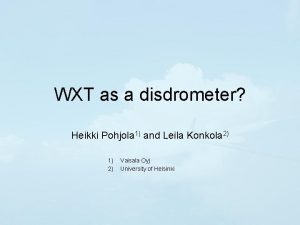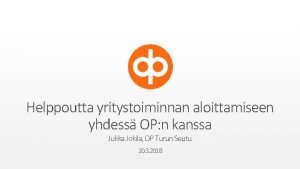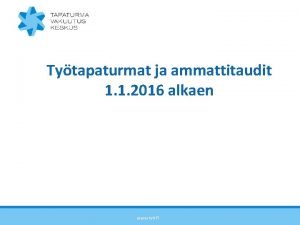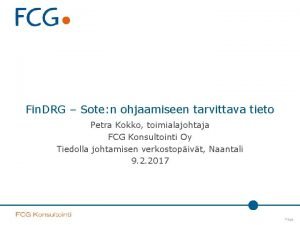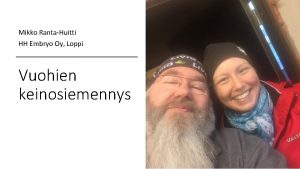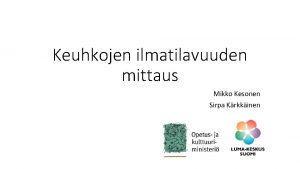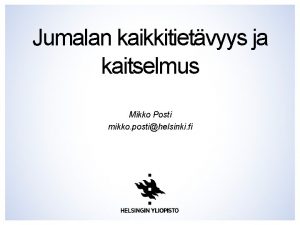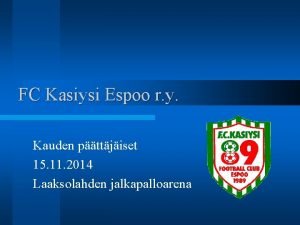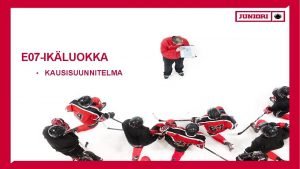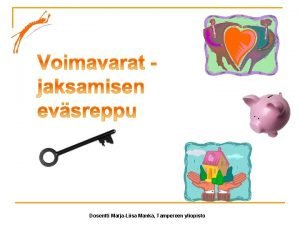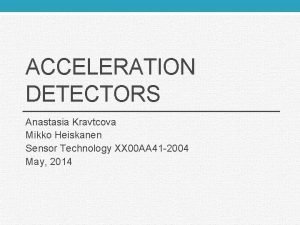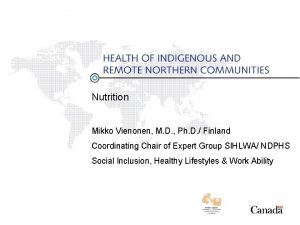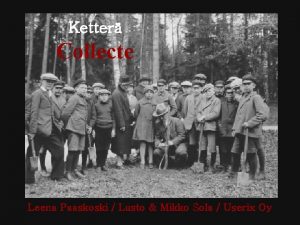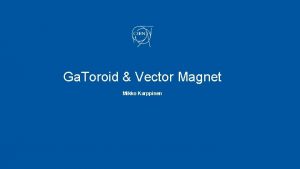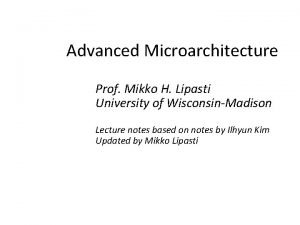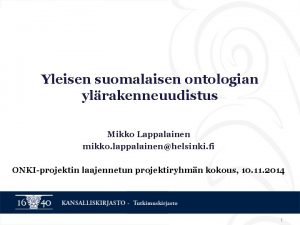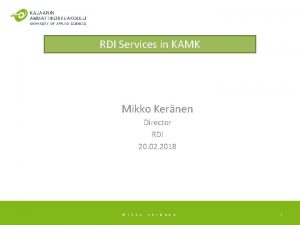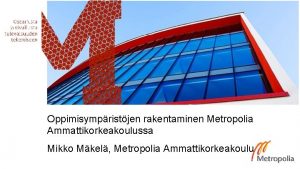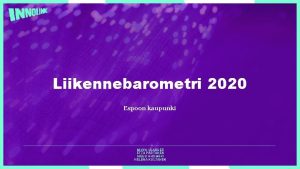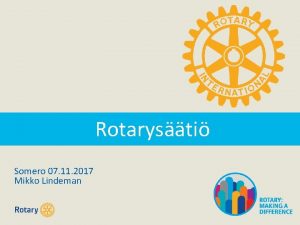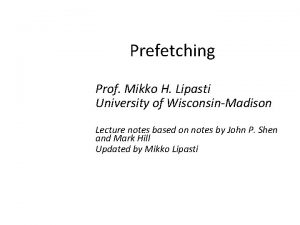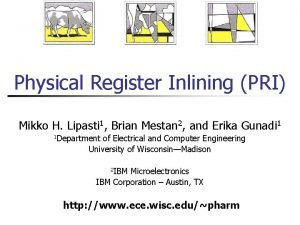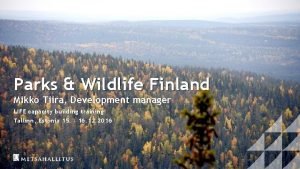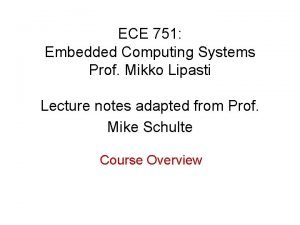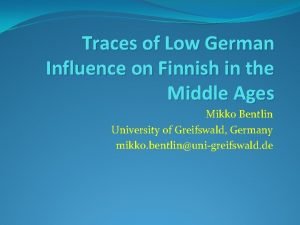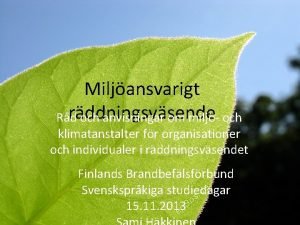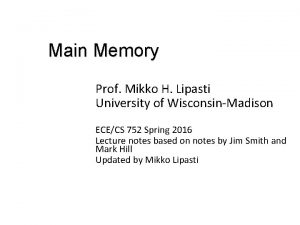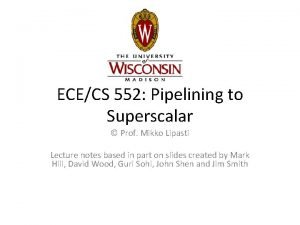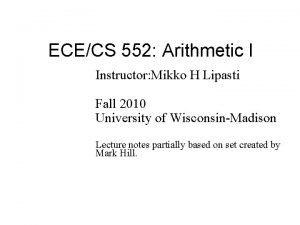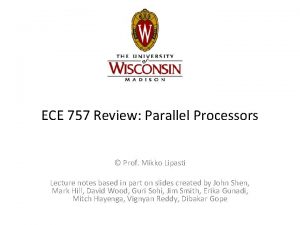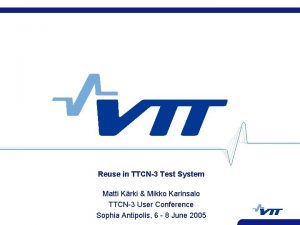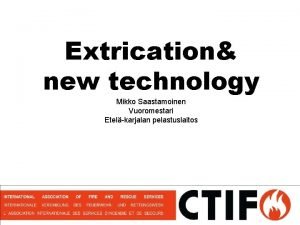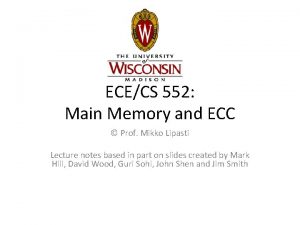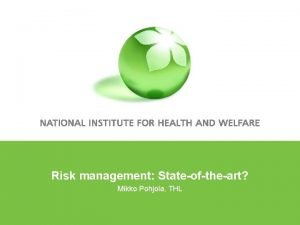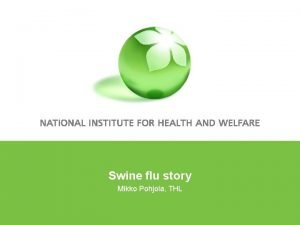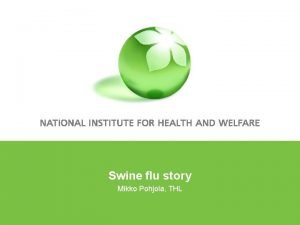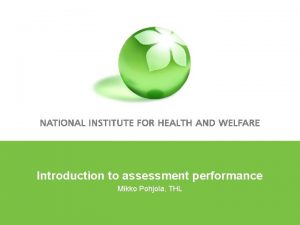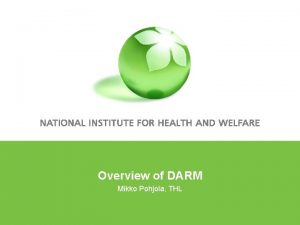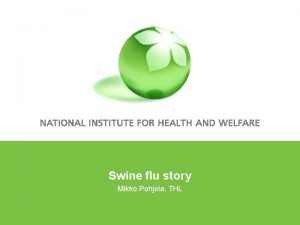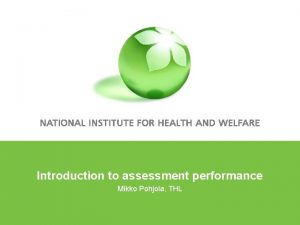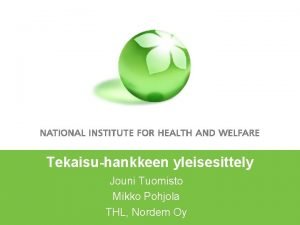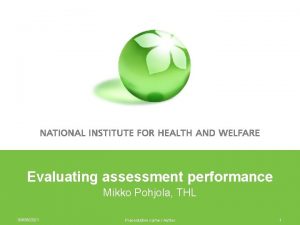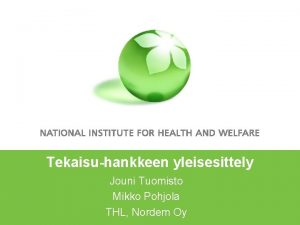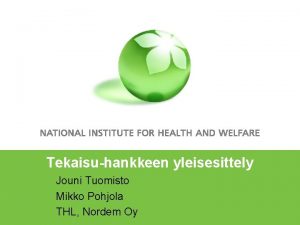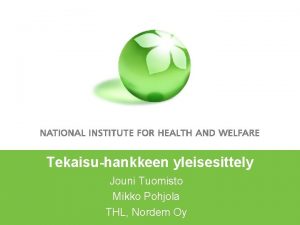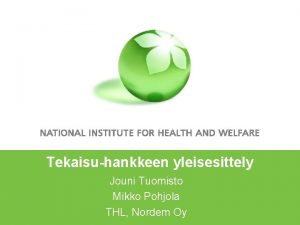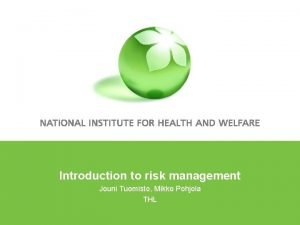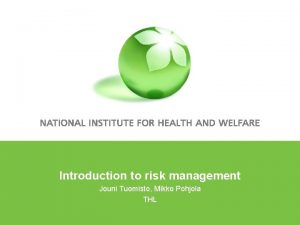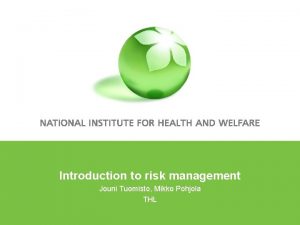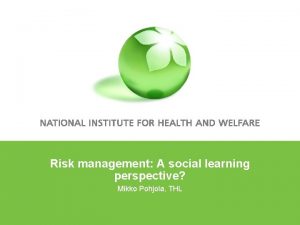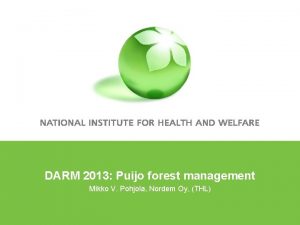Risk management Stateoftheart Mikko Pohjola THL Contents Outline












































- Slides: 44

Risk management: State-of-the-art? Mikko Pohjola, THL

Contents • • • Outline of the RM lectures 30. 3. -7. 4. State-of-the-art in environmental health assessment State-of-the-art in risk management? The reality of risk management? Discussion • Introduction to the RM exercise • RM in the swine flu case

Some concepts & abbreviations • SOTA: State-of-the-art • ~ best common practice • • • DA: Decision analysis RM: Risk management RA: Risk assessment ORM: Open risk management OA: Open assessment DM: Decision making SH: Stakeholder(s) EH: Environmental health (environment and health) EHA: Environmental health assessment EHRM: Environmental health risk management BRA: Benefit-risk analysis

Outline of RM lectures • 30. 3. State-of-the-art? • Theory lecture: frameworks vs. reality • Discussion: RM in the swine flu case • 31. 3. A social learning perspective • Theory lecture: participation, openness, collective learning • Discussion: Citizen perspective to the swine flu RM • 1. 4. Facilitation of (open) risk management • Theory lecture: Pragmatic knowledge services • Exercise: discussion and content evaluation in Opasnet • 7. 4. From needs to knowledge, knowledge to action • Theory lecture: TBD • Discussion: TBD • • 8. 4. Summary/overview of DA & RM 11. -12. 4. Final seminar

Outline to RM lectures • Aims to present and discuss: • Conventional views to RM • Open risk management as an alternative view to RM • What is RM? • What is it perceived to be? • What should it be? • Who does/should it involve?

General RA/RM framework • Systematic analysis according to societal needs

Societal setting for RA/RM Risk assessment is collection, synthesis and interpretation of scientific information and value judgments for use of the society Risk management is use and implementation of that information

SOTA in EHA • BEPRARIBEAN research project • Manuscript: “State-of-the-art in benefit-risk analysis: Environmental health” to be published soon-ish • One out of a set of six “SOTA in BRA” papers • Others domains considered are: Food and nutrition, Food microbiology, Economics and marketingfinance, Medicine, Consumer perception • Available in Heande (link on the course web-page) • Also a “Beyond the SOTA in food and nutrition BRA” manuscript is in preparation • Combines the lessons learned in above mentioned studies

SOTA in EHA • What is the SOTA in EHA? • Underlying: what could food and nutrition BRA learn from the SOTA in EHA?

SOTA in EHA • 8 approaches to environmental health assessment: • • Red Book risk assessment Understanding risk IRGC risk governance framework Chemical risk assessment: REACH Environmental impact assessment: YVA Health impact assessment (HIA) Integrated environmental health impact assessment (IEHIA) Open assessment • Why not: • Life-cycle assessment? • Nuclear safety assessment? • Silver Book?

SOTA in EHA • Analysis framework: • Purpose: What need(s) does an assessment address? • Problem owner: Who has the intent or responsibility to conduct the assessment? • Question: What are the questions addressed in the assessment? Which issues are considered? • Answer: What kind of information is produced to answer the questions? • Process: What is characteristic to the assessment process? • Use: What are the results used for? Who are the users? • Interaction: What is the primary model of interaction between assessment and using its products? • Performance: What is the basis for evaluating the goodness of the assessment and its outcomes? • Establishment: Is the approach well recognized? Is it influential? Is it broadly applied?

SOTA in EHA • Interaction: • Trickle-down: Assessor's responsibility ends at publication of results. Good results are assumed to be taken up by users without additional efforts. • Transfer and translate: One-way transfer and adaptation of results to meet assumed needs and capabilities of assumed users. • Participation: Individual or small-group level engagement on specific topics or issues. Participants have some power to define assessment problems. • Integration: Organization-level engagement. Shared agendas, aims and problem definition among assessors and users. • Negotiation: Strong engagement on different levels, interaction an ongoing process. Assessment information as one of the inputs to guide action. • Learning: Strong engagement on different levels, interaction an ongoing process. Assessors and users share learning experiences and implement them in their respective contexts. Learning in itself a valued goal. • A continuum of increasing engagement and power sharing

SOTA in EHA • Legend for following process diagrams: • Process/work: thin-border box or bulky arrow • Products: thick-border box • Information flow: thin solid arrow

NRC: Red book Risk assessment Observations Hazard identification Extrapolation Dose-response assessment Risk management Regulatory options Risk characterization Measurements and population characteristics Exposure assessment Evaluation of options Decisions and actions NRC 1983. Risk Assessment in the Federal Government: Managing the Progress. The National Research Council. National Academy Press, Washington D. C.

NRC: Understanding Risk (Orange book) Role and importance of deliberation Risk characterization as the link between assessment and management Learning and feedback Public officials Natural and social scientists Interested and affected parties Problem formulation Process design Selecting options & outcomes Information gathering Synthesis Decision Implementation Evaluation Analysis and deliberation NRC 1996. Understanding Risk: Informing Decisions in a Democratic Society. The National Research Council. National Academy Press, Washington D. C.

IRGC – Risk governance Management sphere: Decision & implementation of actions Assessment sphere: Generation of knowledge Pre assessment Risk management Implementation ▪ Problem framing ▪ Early warning ▪ Screening ▪ Determination of scientific conventions ▪ Option realization ▪ Monitoring & control ▪ Feedback from risk management practice Communication Decision making Risk appraisal Risk assessment ▪ Hazard identification & estimation ▪ Exposure & vulnerability assessment ▪ Risk estimation Concern assessment ▪ Option identification & generation ▪ Option assessment ▪ Option evaluation & selection ▪ Risk perceptions ▪ Social concerns ▪ Socio-economic impacts Tolerability & acceptability judgement Risk evaluation Risk characterization ▪ Judging tolerability & acceptability ▪ Need for risk reduction measures ▪ Risk profile ▪ Judgment of the seriousness of risk ▪ Conclusions & risk reduction options IRGC 2005. Risk governance – towards an integrative approach. International Risk Governance Council. Geneva.

REACH – EU Chemical safety Information: available vs. required/needed ▪ Substance intrinsic properties ▪ Manufacture, use, tonnage, exposure, risk management Exposure assessment ▪ Hazard identification ▪ Classification & labeling ▪ Derivation of threshold levels ▪ PBT/v. Pv. B assessment ▪ Exposure scenarios building ▪ Exposure estimation no Iteratio n Hazard assessment yes Dangerous or PBT/v. Pv. B Risk characterisation yes Chemical safety report no Risk controlled ECHA 2008. Guidance on Information Requirements and Chemical Safety Assessment. Guidance for the Implementation of REACH.

YVA - regulatory EIA in Finland Phase 2 Evaluation program Statements of the ministry of employment and economy about the report Participation Phase 1 Opinions and statements about the program Participation Statements of the ministry of employment and economy about the evaluation Opinions and statements about the report Assessment Evaluation report Pohjola et al. State of the art in benefitrisk analysis: Environmental health. Manuscript.

Health impact assessment (HIA) Policy and programme development phase for prospective assessments Screening Scoping Appraisal Policy implementation phase Reporting Monitoring Pohjola et al. State of the art in benefitrisk analysis: Environmental health. Manuscript.

IDEA framework (IEHIA/INTARESE) Briggs: A framework for integrated environmental health impact assessment of systemic risks. Environmental Health 2008, 7: 61.

Open assessment Participant’s knowledge rc ep ing n k ma Participant’s updated knowledge ion cis n tio ep tio Participant’s knowledge De n tio u r ib nt o C rc Pe Pe Assessment Decision ibutio n Updated assessment Participant’s knowledge Contr Participant’s updated knowledge Pohjola et al. State of the art in benefitrisk analysis: Environmental health. Manuscript.

Main findings • EHA is a very complex field • Environment? • Health? • No single SOTA approach exists • Approaches often either academic or regulatory • Assessment centered vs. management centered? • Traditional and novel approaches • Regulatory and traditional tend to be more established

EHA NOTE: this is an influence diagram (not a process diagram) Adapted from Briggs: A framework for integrated environmental health impact assessment of systemic risks. Environmental Health 2008, 7: 61.

Main findings • Purpose: All state to aim to support societal decision making • Question, answer, process: Quite different operationalization of the (stated) aims • Question, answer: Huge differences in scopes • Process, interaction: Mostly expert activity in institutional settings • Performance: Societal outcomes hardly ever considered

Assessment – management interaction

Main findings • The key issues in benefit-risk analysis in environmental health are not so much related to the technical details of performing the analysis, but rather: • i) the level of integration (cf. Scope) • ii) the perspective to consider the relationship between assessment and use of its outcomes in different assessment approaches • “Assessment push” or “needs pull” • The means of aggregation are basically the same as in other fields • e. g. DALY, QALY, willingness-to-pay (WTP)

Main findings • In EHA there are tendencies towards: • a) increased engagement between assessors, decision makers, and stakeholders • b) more pragmatic problem-oriented framing of assessments • c) integration of multiple benefits and risks from multiple domains • d) inclusion of values, alongside scientific facts, in explicit consideration in assessment • Indicative of the incapability of the common contemporary approaches to address the complexity of EHA? • Does not necessarily show much (yet) in practice

Implications to RM? • RM more or less included in the approaches • E. g. YVA & REACH are actually RM approaches that include assessment • Purpose, use, interaction, … all (somewhat) acknowledge RM and the broader societal context

Other perspectives to RM • For example: • The EHRM framework by The Presidential/Congressional Commission on Risk Assessment and Risk Management • Risk-based decision making framework, i. e. The NRC Silver Book approach

EHRM framework The Presidential / Congressional commission on Risk Assessment and Risk Management: Final Report Volume 1, 1997.

NRC: Science and decisions (Silver book) NRC 2009. Science and Decisions: Advancing Risk Assessment. The National Research Council. National Academy Press, Washington D. C.

How does RM look like according to the frameworks? • • • Mostly institutional Professional/expert-based Often considered as single-actor activity Primarily unidirectional (knowledge push) Rational Quite straightforward • Implementation of decisions is not the (big) problem • Is this a realistic view?

How does RM look like according to the frameworks? • A caricature of traditional risk research • Risk assessment: Scientific experts deal with scientific facts • Risk management: Professional decision makers make decisions according to the scientific facts • Risk communication: Commuication experts explain the decisions and the facts to the ignorant (stakeholders, NGO’s, public, …) • Risk perception: Scientific experts analyze why do not the ignorant understand the facts • Also in DA there are two branches • What decision should be taken? • How are decisions actually made? • Are distinctions necessary? Does it correspond with reality and practical needs? Do these things need to be kept separate?

Reality of EHRM? • Environment and health relevant to everyone • • • Multiple relevant decision situations Multiple relevant questions Multiple relevant actors Multiple relevant roles Multiple relevant sources of knowledge • Experts and professional (societal) decision makers of course, but also: • DMs in business and industry • NGO’s • Common citizens

Reality of EHRM? • Reality is much more complex than the (common) RM frameworks recognize/describe • Simplicity -> explicitness -> good guidance? • Should it not be possible to expand the scope of systematic analysis/practice? • The emerging approaches in EHA more or less aim to merge assessment and management into an intertwined social knowledge process • Assumes a too rational and straightforward practice of assessment, management, and implementation?

Discussion Intro to RM exercise RM in the swine flu case

RM exercise • Individual work • Max. score 10 points • Course total max. 45 points • Reports are written in Opasnet • Pages were created for each student in the introduction to Opasnet lecture 4. 3. • Presentations of reports in final seminar 11. -12. 4. • If needed, improvements can be made up to the final evaluation in the end of April

RM exercise • Task description: • Consider yourself in the role of the Ministry of Social and Health affairs • Development of capacity to manage major public health risks • Evaluate all four DA study plans from the use/r point of view: • What value would each planned analysis bring you? • Make use of the properties of good assessment framework: • Relevance (is content relevant in relation to purpose? ) • Pertinence (is purpose relevant in relation to use? ) • Usability (does your understanding increase? ) • Availability (is information accessible and/or timely? ) • Acceptability (Would results/conclusions be acceptable to you? Why or why not? ) • Give an overall statement: would/could the analysis influence your practices (in the given imaginary role)? Also explain how

RM exercise • Task description (continued): • Take (one) another perspective and repeat the evaluation of the DA study plans • E. g. common citizen, medical superintendent in a hospital, health researcher, journalist, nurse in public health care, principal of an elementary school, … • Focus on the differences in comparison to the above evaluation • Write an (freely formatted) evaluation report and present the main findings in the final seminar • More detailed instructions (will be) available on the exercise web-page in Opasnet

Properties of good assessment

Reasons for changing exercise part 2 • More explicit task (? ) • Clearer linkage between DA & RM • Students can better make use of their earlier efforts in working on the DA study plans • Might help in improving the study plans too! • Emphasizes different perspectives to DA & RM • First half of the course mostly expert/assessor point of view • Activates collaboration and cross-fertilization between students and groups • Collective learning!

Discussion: RM in the swine flu case • • What risks exist(ed) in the swine flu case? What risks are/were addressed? How? Who are/were in the roles of managing the risks? Who else are/were involved? What roles do/did they take? • On what basis do/did different actors take action to manage (in a way or another) the risks?


Concepts • Some basic concepts: • • Performance = goodness! Assessment, Management Model Process (making/using), Product Output, Outcome Assessor, Decision/Policy maker, Stakeholder Participant, User
 Heikki pohjola
Heikki pohjola Avainlukulistan vaihto op mobiili
Avainlukulistan vaihto op mobiili Sairausajan palkka työtapaturma pohjola
Sairausajan palkka työtapaturma pohjola Petra kokko thl
Petra kokko thl Turbosound thl 811
Turbosound thl 811 Market risk assessment
Market risk assessment Key risk indicators financial risk management
Key risk indicators financial risk management Risk map risk management
Risk map risk management Citation sandwich example
Citation sandwich example Mikko ranta-huitti
Mikko ranta-huitti Kennel dosmarin kokemuksia
Kennel dosmarin kokemuksia Mikko posti
Mikko posti Mikko häikiö
Mikko häikiö Sara leitsamo
Sara leitsamo Mikko juusela
Mikko juusela Mikko manka tampereen yliopisto
Mikko manka tampereen yliopisto Mikko heiskanen
Mikko heiskanen Mikko vienonen
Mikko vienonen Modulaarinen tuotekehitys
Modulaarinen tuotekehitys Mikko karppinen
Mikko karppinen Mikko lipasti
Mikko lipasti Mikko lappalainen
Mikko lappalainen Mikko keränen kamk
Mikko keränen kamk Mikko mäkelä metropolia
Mikko mäkelä metropolia Mikko ranta njs
Mikko ranta njs Mikko ulander
Mikko ulander Mikko h. lipasti
Mikko h. lipasti Mikko lindeman
Mikko lindeman Mikko lipasti
Mikko lipasti Pri register
Pri register Mikko tiira
Mikko tiira Mikko nieminen
Mikko nieminen Mikko h. lipasti
Mikko h. lipasti Mikko lipasti
Mikko lipasti Mikko bentlin
Mikko bentlin Tietovirtakaavio
Tietovirtakaavio Mikko routala
Mikko routala Mikko h. lipasti
Mikko h. lipasti Mikko lipasti
Mikko lipasti Mikko h. lipasti
Mikko h. lipasti Mikko lipasti
Mikko lipasti System by mikko
System by mikko Mikko lipasti
Mikko lipasti Ked ferno
Ked ferno Ecc syndrome
Ecc syndrome
